Related Research Articles

The Chrysler B and RB engines are a series of big-block V8 gasoline engines introduced in 1958 to replace the Chrysler FirePower engines. The B and RB engines are often referred to as "wedge" engines because they use wedge-shaped combustion chambers; this differentiates them from Chrysler's 426 Hemi big block engines that are typically referred to as "Hemi" or "426 Hemi" due to their hemispherical shaped combustion chambers. The corporation had been seeking a smaller and lighter replacement for its FirePower engines, in part because new styling dictates meant moving the engine forward in the chassis which negatively affected weight distribution.

The LA engine is a family of overhead-valve small-block 90° V-configured gasoline engines built by Chrysler Corporation between 1964 and 2003. Primarily V8s, the line includes a single V6 and V10, both derivations of its Magnum series introduced in 1992. A replacement of the Chrysler A engine, they were factory-installed in passenger vehicles, trucks and vans, commercial vehicles, marine and industrial applications. Their combustion chambers are wedge-shaped, rather than polyspheric, as in the A engine, or hemispheric in the Chrysler Hemi. LA engines have the same 4.46 in (113 mm) bore spacing as the A engines.

The Chrysler A engine is an OHV small-block V8 gasoline engine built by Chrysler from 1956 until 1967. It featured polyspherical combustion chambers, and was offered in displacements from 276.1 cu in (4.5 L) to 325.2 cu in (5.3 L), and in various high-power configurations. It began to be replaced by the wedge-head LA engine in 1964, and is not related to the hemispherical-head Hemi engine of the 1950s or 1960s.
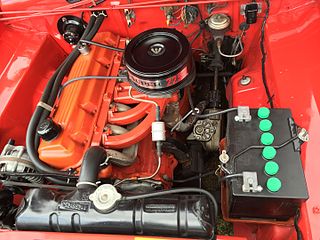
The Slant-Six is the popular name for a Chrysler inline-6 internal combustion engine with an overhead valve reverse-flow cylinder head and cylinder bank inclined at a 30-degree angle from vertical. Introduced in 1959 for the 1960 models, it was known within Chrysler as the G-engine. It was a clean-sheet design that began production in 1959 at 170 cubic inches (2.8 L) and ended in 2000 at 225 cubic inches (3.7 L). It was a direct replacement for the flathead Chrysler straight six that the company started business with in 1925 until the old design was discontinued in the 1960s.

The Chrysler 1.8, 2.0, and 2.4 are inline-4 engines designed originally for the Dodge and Plymouth Neon compact car. These engines were loosely based on their predecessors, the Chrysler 2.2 & 2.5 engine, sharing the same 87.5 mm (3.44 in) bore. The engine was developed by Chrysler with input from the Chrysler-Lamborghini team that developed the Chrysler/Lamborghini Formula 1 V12 engine in the early 1990s.

The Chrysler flathead engine is a flathead automotive engine manufactured by the Chrysler Corporation from 1924 through the early 1960s. The flathead engine came in four-,six-, and eight-cylinder configurations and varying displacement, with both a cast iron and cast aluminum cylinder head. It was installed in Chrysler, DeSoto, Dodge and Plymouth branded vehicles.

The initial design development for the PowerTech V6 and V8 engine family was done by American Motors Corporation (AMC) and debuted in 1998 with credit to Chrysler. This was the first new V8 engine for Chrysler since the 1960s. The companion V6 was basically the V8 with two fewer cylinders, another concept that originated at AMC before the company joined Chrysler. These new engines had nothing in common with the Chrysler A engine V8s, nor the Jeep 4.0 L "PowerTech" I6 engine.

The Chrysler 3.3 and 3.8 engines are V6 engines used by Chrysler from 1989 to 2011. This engine family was Chrysler's first 60° V6 engine designed and built in-house for front wheel drive vehicles, and their first V6 not based on a V8. It was designed as a larger, more powerful alternative to the Mitsubishi 3.0 V6 in the minivans and debuted in 1989 for the 1990 model year. They were later also used in some rear wheel drive cars like the Jeep Wrangler.

The Chrysler Hemi-6 engine is a family of inline six-cylinder petrol engines produced by Chrysler Australia in three piston displacements and multiple configurations. Hemi-6 engines were installed in Australian-market Chrysler Valiants from 1970 through 1981. It was also installed in the Valiants closely related variants, the Chrysler VIP, the Chrysler by Chrysler & the Valiant Charger.

The Dodge Coronet is an automobile that was marketed by Dodge in seven generations, and shared nameplates with the same bodyshell with varying levels of equipment installed. Introduced as a full-size car in 1949, it was the division's highest trim line and moved to the lowest level starting in 1955 through 1959. The name was reintroduced on intermediate-sized models from the 1965 until 1976 model years. Muscle car versions were available starting in 1965 with the 383 and 426 wedge cu in Chrysler RB engine, followed in 1966 by the powerful 426 cu in Chrysler Hemi. Other performance models included the "Superbee", and featured, the 383 cu in Magnum, among other engine options. The nameplate "coronet" is a type of crown worn by royalty.
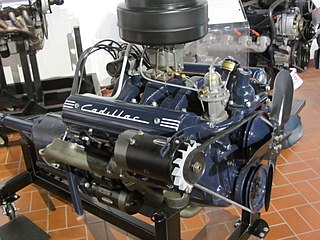
The term Cadillac V8 may refer to any of a number of V8 engines produced by the Cadillac division of General Motors since it pioneered the first such mass-produced engine in 1914.
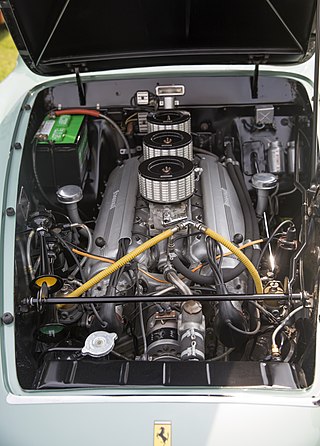
The Ferrari Lampredi engine was a naturally aspirated all aluminum 60° V12 engine produced between 1950 and 1959. Inline-4 and Inline-6 variants for racing were derived from it.
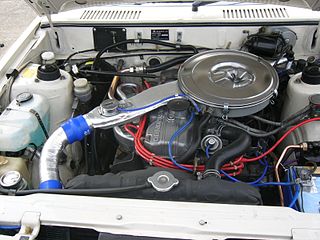
The Mitsubishi Astron or 4G5/4D5 engine, is a series of straight-four internal combustion engines first built by Mitsubishi Motors in 1972. Engine displacement ranged from 1.8 to 2.6 litres, making it one of the largest four-cylinder engines of its time.

The Lincoln Y-block V8 engine was Ford's earliest OHV V8 engine, introduced by Lincoln in the 1952 model year. Like the later and better-known but even more short-lived Ford Y-block engine, its block's deep skirts gave the block the appearance of the letter Y from the front.

The Chrysler Hemi engine, known by the trademark Hemi or HEMI, refers to a series of high-performance American overhead valve V8 engines built by Chrysler with hemispherical combustion chambers. Three generations have been produced: the FirePower series from 1951 to 1958; a famed 426 cu in (7.0 L) race and street engine from 1964-1971; and family of advanced Hemis (displacing between 5.7 L 6.4 L from 2003 to the present.

The single overhead cam V6 engine introduced in 1993. It was derived from Chrysler's first homegrown front-wheel drive V6, the Chrysler 3.3 engine. The SOHC V6 has been replaced by the Chrysler Pentastar engine.

The Chrysler Falcon is a two-seat roadster concept car commissioned by Chrysler and built by Carrozzeria Ghia for the 1955 model year. The car was never put into production, but some of its features reappeared on later Chrysler designs.
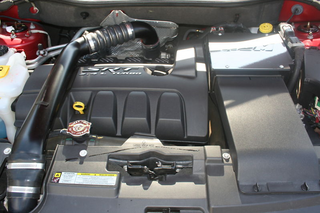
The World Gasoline Engine is a family of straight-4 piston engines, based on the Global Engine Alliance design.

The Dodge Series D8 appeared in October 1937 for the 1938 model year, replacing the previous year's Series D5. Production of the 1938 Dodges ran from September 1937 until July 1938, which was the typical pattern for Dodge in this period. As before, there was also a "Junior" line of Plymouths using Dodge badges and trim for the Canadian and global export markets. The main version is sometimes referred to as the "Senior" Dodge to distinguish the two.
References
- 1 2 3 4 "The 1956-1967 Plymouth Polyspherical Head Explained". Eric B. White Digital Documents Library. Automotive History Preservation Society. Archived from the original on 2022-06-29.